MAD architects completes sinuous stadium of its quzhou sports park
a monumental landmark with an organic design
MAD Architects completes its Quzhou Stadium, the centerpiece of the vast sports park covering nearly 700,000 square meters (173 acres) of China‘s Zhejiang Province. Led by Ma Yansong, the team designs the complex for the historic city of Quzhou 400 kilometers (250 miles) southwest of Shanghai. The city is nestled among dense forests and neighbors a mountain range, natural elements from which the design draws its organic qualities. The architects note that the landscape ‘evokes those of planets imagined by visionary science fiction authors.’
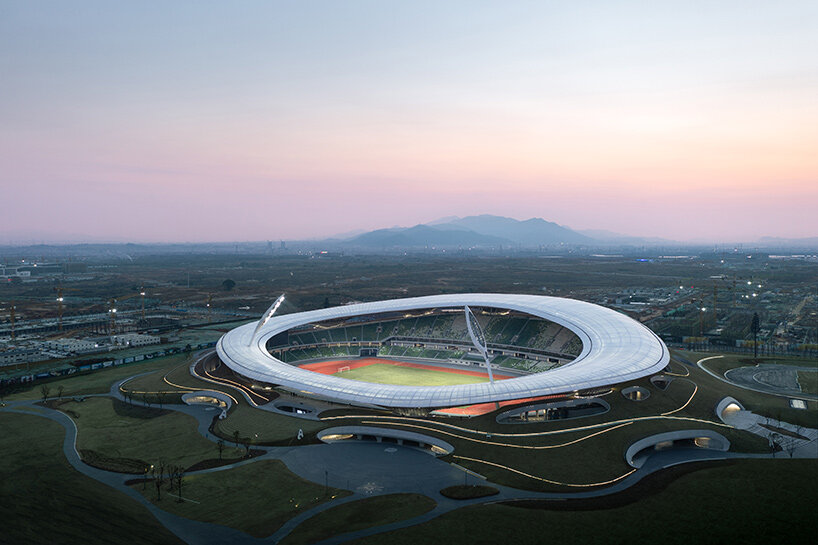 image by CreatAR Images | all images © MAD Architects
image by CreatAR Images | all images © MAD Architects
mad architects integrates the architecture into the landscape
While the completed Quzhou Stadium seats 30,000 spectators, MAD Architects avoids an imposing, invasive architecture. Instead, the built space is fluidly integrated into the surrounding landscape, suggesting a continuation of the rolling ground rather than an object atop it. The team writes: ‘Unlike the typically fortress-like stadiums built in urban areas around the world, MAD Architects was determined to build a stadium that would embed much of the technology that went into its production so that it can instead be open to the surrounding public space from nearly every angle.’
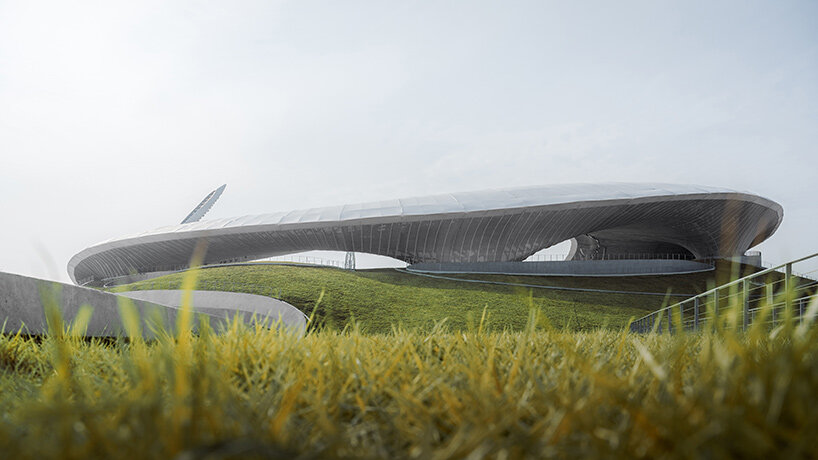
image by CreatAR Images
a ‘land art’ stadium in quzhou
While the grounds of Quzhou Stadium serve as a dynamic park space neighboring the city, MAD Architects considers this area ‘an opportunity for a spiritual connection between people and nature.’ For Ma Yansong, ‘the Quzhou stadium breaks away from the conventional sports architecture. It is conceived as a piece of land art that submerges itself into the nature and welcomes everyone to gather and share the sports spirit.’
Seeking this ‘land art’ quality, the architects carry the undulations of the surrounding topography through to the sloping facade. Here, visitors are invited to ‘determine for themselves where the landscape ends and the building begins.’ Even after the stadium closes its doors, visitors are encouraged to engage with the structure, climbing it as a landscaped park.
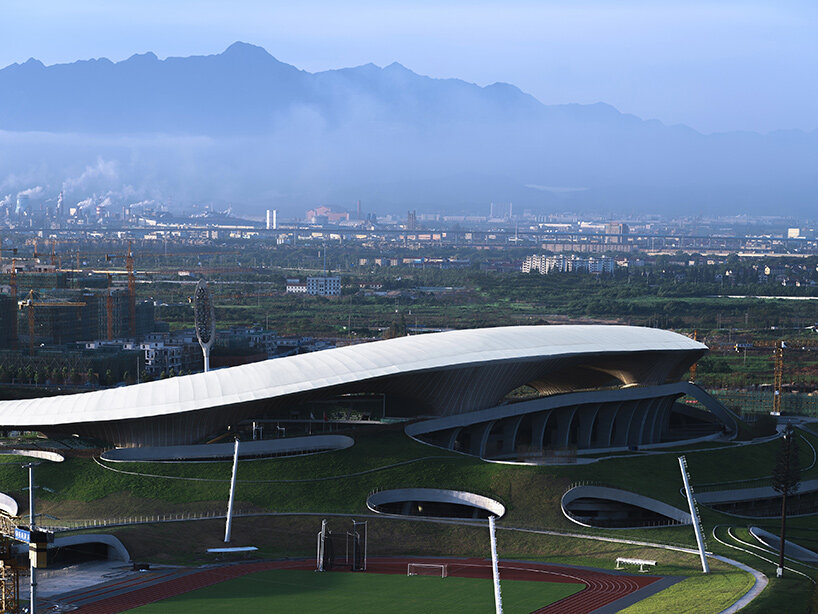 image by Arch Exist
image by Arch Exist
The light-emitting canopy
The stadium is supported by sixty sets of concrete column walls, each built of exposed wood-grained fair-faced concrete sheet walls. This strategy introduces a quality of warmth and texture to the stark material, while the array of columns succeeds in obscuring the threshold between the interior and exterior. Inside, the canopy overhead is fabricated with a substructure of self-supporting steel, shrouded in a translucent, light-emitting membrane. This material is stretched across the framework to create the complex, geometries desired.
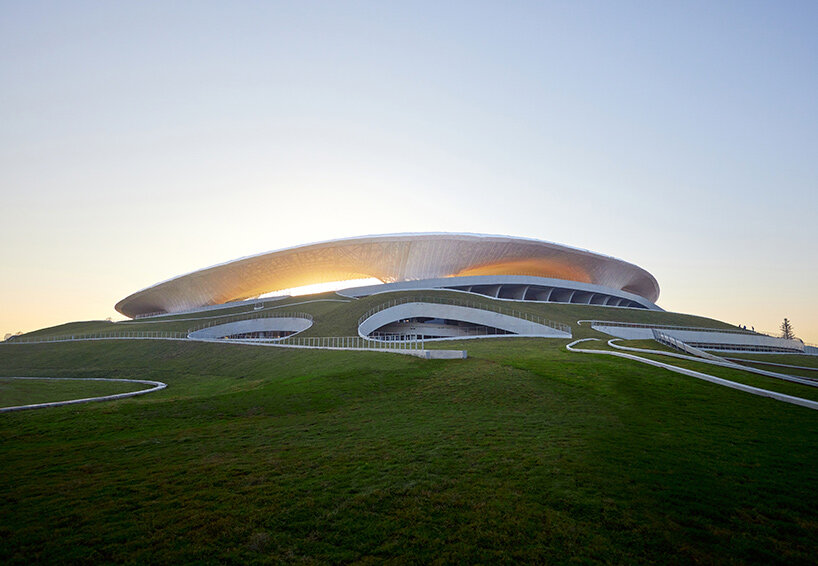 image by Aogvision
image by Aogvision
The team describes the canopy structure: ‘Appearing from a distance like a halo hovering gently above the landscape, the overhanging structure of Quzhou Stadium is the newest crown jewel of the city. Visitors approach the stadium by walking through the canopy from one of eight entrances, all of which feature complex double-curved surfaces that ripple overhead like ocean waves.
‘The canopy is supported by only nine drop points with a maximum span of ninety-five meters between them to allow the building to ‘float’ over the landscape while offering framed perspectives of the city from many points of view.’
‘Though the canopy is composed of a monumental steel frame, it appears lightweight thanks to the light-transmitting synthetic polymer PTFE membrane wrapped around the lower half of the structure that is composed of micro-perforations to improve the acoustic performance throughout the stadium. The upper surface of the canopy is composed of a more solid PTFE membrane to prevent rain from entering the seating bowl.’
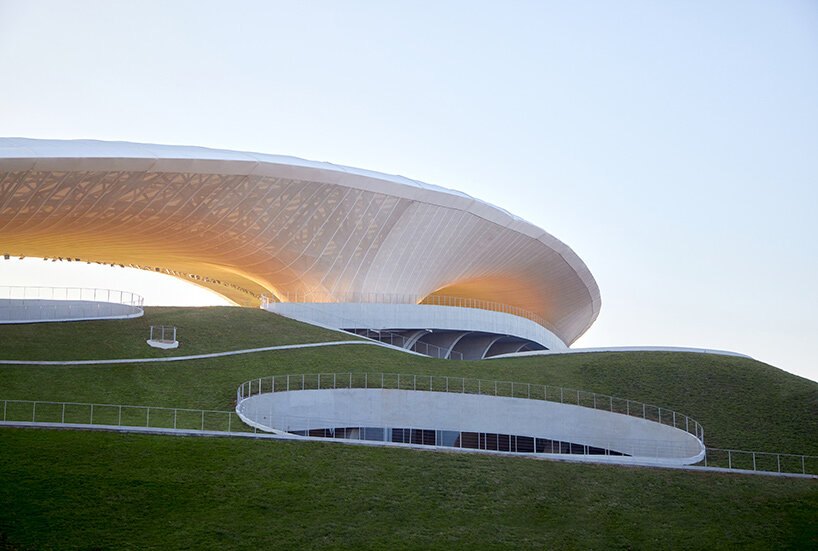
image by Aogvision
plans for the larger sports park
The completed Quzhou Stadium marks the first of two construction stages for the larger Quzhou Sports Park. The ambitious project was first unveiled in 2018 (see designboom’s coverage here) and will include a 10,000 seat gymnasium, a 2,000 seat natatorium, a science and technology museum, a hotel, youth center, and retail programs.
‘The design of the buildings placed throughout the park break away from the traditional way of highlighting the structural strength of athletic facilities to instead convey a subtle inner beauty. When complete, Quzhou Sports Park will become the largest earth-sheltered complex in the world, and will provide a much-needed contrast to the dense urban fabric of the region.’
